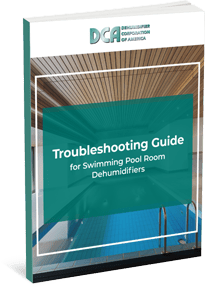Out-of-control high humidity in water treatment plants is one of the most significant challenges that operators have to deal with. When the humid air in these facilities meets a cold surface and condenses, that condensation can cause corrosion, rusting, and the formation of mold and mildew. This results in unplanned, costly maintenance and possible premature equipment failure.
Moisture can enter a water treatment facility in several ways. A loosely constructed above-ground building allows air to pass freely through the walls and ceiling. Many times the humidity in a building rises and falls with what goes on outdoors if an inadequate non-permeable vapor barrier is not placed in the walls and ceilings. Loosely constructed doors and windows also have to be adequately weather-stripped. Underground facilities’ walls, floors, and ceilings must also be addressed as well.
A dehumidification system designed for water treatment facilities is a key piece of equipment that prevents excess moisture from accumulating on critical components in a water treatment facility. Dehumidifiers, designed for water treatment plant duty, have the capability to operate in low ambient temperatures down to 60 degrees F. whereas other dehumidifiers may not. Read on to learn more about dehumidification for water treatment plants.
Humidity Challenges of Water Treatment Plants/Facilities
The greatest challenge of a water treatment plant has to do with housekeeping—the threat of mildew, mold, rust, and corrosion on all condensable surfaces. Usually, cold water from lakes or wells can range from 33 °F to 60 °F. The water treatment facility can be above or below grade, presenting different problems.
Condensation can form any cold surface that cools below the room’s dew point temperature. Moisture can also enter the facility via the intended outdoor makeup air. A proper water treatment dehumidification system controls the room’s dew point to about 5 °F below the coldest surface temperature in the facility. A dedicated outdoor makeup air dehumidifier can be added to remove moisture from outdoor air before it enters the facility if needed.
The facility’s components—electric motor-driven water pumps, electrically operated water control valves, valve actuators, electrical control panels, water holding tanks, pipe galleries, and connecting pipes—are all susceptible to damage due to excess moisture in the air. Electric motor-driven water pumps can draw in moisture when cooling down after shutdown, which can mean they short out at the next startup. Under and above-ground concrete floors and walls can also sweat, creating slippery, hazardous surfaces for people and machinery. Constant standing water on floors and/or weeping wall problems must be corrected first, as normal dehumidification alone will not be enough.
Without a dedicated dehumidification system designed for water treatment plants and proper air circulation through an air duct system, excessive moisture will cause sweating on all condensable surfaces, accelerating rust and corrosion on metal as well as mold and mildew on walls and floors. Installing a dehumidifier designed for water treatment plants is the first step to solving moisture-related problems. The next step is an adequate duct system, which will circulate dry air throughout the structure to eliminate pockets of dead air.
Water treatment plants face various challenges related to excess humidity, including:
- Oxidation: If the room’s dew point is not controlled at least 5 degrees F, below the coldest surface temperature in the room, oxidation in form of rusting can occur.
- Condensation: Lowering the dew point will lower humidity levels and prevent condensation throughout the facility.
- Bacteria growth: If RH rises above 70%, bacteria growth accelerates.
- Mold and mildew can occur in areas of the building that suffer from little or no air movement from the dehumidification system.
How Does Controlling Humidity Benefit Water Treatment Plants/ Facilities?
Controlling humidity in water treatment plants is vital. Here are the primary benefits:
- Reduces the cost of pipe maintenance: Mold and corrosion can affect pipes in a humid environment. Even metal surfaces coated with a durable epoxy designed to resist corrosion can eventually break down in the presence of excess moisture. Therefore, water treatment facilities will be forced to remove all of this rusting and scaling down to clean bare metal and recoat with suitable undercoating and an epoxy top coating designed for this condition.
- Minimizes or eliminates downtime: Electrical power panels contain fuses and circuit breakers that usually run warmer than room temperature, thus drawing in moisture that may corrode them and cause premature failure. During shutdown, electric motor-driven water pumps can draw in moisture as they cool. When they are restarted, the moisture buildup on the internal components can lead to short, causing major failures that require complete replacement.
- Maintains a corrosion-free environment: Recurrent condensation on pipes due to humidity can lead to corrosion, causing issues like site structural failures and damage to monitoring equipment. Controlling the humidity level will prevent every metal surface in the facility from rusting or corroding.
- Maintains a mold-free environment: Condensation from wet walls and floors can cause mold and mildew, especially in areas with insufficient air circulation. Mold and mildew promote bacterial growth, which causes foul odor and an unhealthy, uncomfortable atmosphere for workers. If the structure contains frame (wood) walls mold can form within the wall. This can go unnoticed until it shows up on the interior surface as “black mold” many times meaning a total teardown and replacement.
DCA Dehumidifier Solutions for Water Treatment Plants
Dehumidifier Corporation of America (DCA) is a leading company offering dehumidifying solutions for water treatment plants. Water treatment plants present unique challenges since they have much cooler operating temperatures, and dehumidifiers are designed for low-temperature operation. DCA dehumidifiers for water treatment plants offer optional remote condensers allowing the system to deliver warm or cool dry air to the room.
With the addition of an optional addon gas or electric furnace, our dehumidifiers supply the cooling or heating needed to maintain the desired room temperature and relative humidity. One of our recent case studies has shown that low-temperature dehumidification can help ward off rust and corrosion on facility equipment as outside temperatures fluctuate. In cold climates, we may add extra add-on room heating systems to satisfy heating requirements.
Depending on your facility, our equipment can be installed indoors, outdoors, or on the rooftop. There are horizontal and vertical configuration options depending on the ductwork and installation location. The dehumidifier controls can be integrated into the building management system or installed as a simple wall humidistat.
Contact DCA Today
Dehumidifiers are undeniably crucial equipment for water treatment facilities. They help limit moisture that may condense and corrode metal surfaces and damage electrical components.
Dehumidifier Corporation of America is an experienced dehumidifier supplier offering dehumidification solutions since 1995. We can help you select and install dehumidifiers that suit your water treatment plant. For more information about our services, please don’t hesitate to contact us.
























